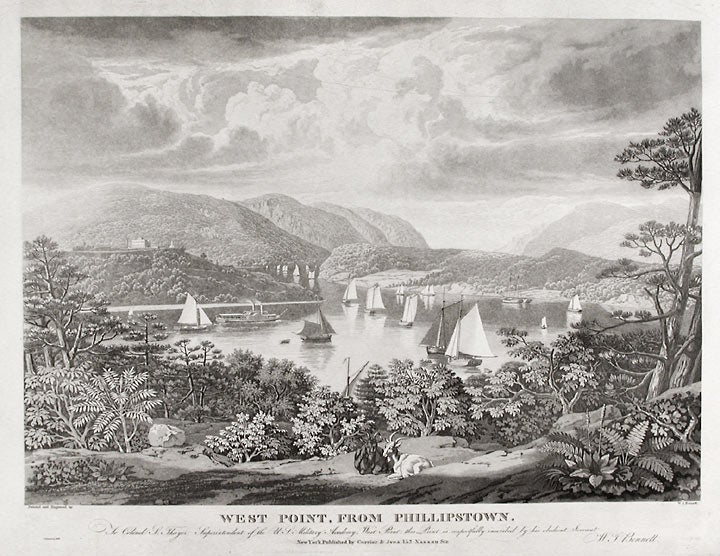BENNETT, William James (c.1784-1844)
West Point from Phillipstown. To Colonel S. Thayer Superintendant of the U.S. Military Academy, West Point
Printed by Editions Alecto and Master Printer Edward Egerton-Williams, [circa 1980]. Aquatint engraving. Trial proof impression printed in black and white. Impression limited to 50 copies, from the original copper plate. In perfect condition. Image size: 16 x 22 1/2 inches. Sheet size: 22 5/8 x 28 3/8 inches. Plate mark: 19 3/4 x 26 7/8 inches.
William James Bennett (c. 1787-1844) was born in England and received his training at the Royal Academy. He emigrated to the United States in 1826, and is best known for his views of American cities, including the Hudson Valley Region, Niagara Falls, and numerous port cities such as New York, Charleston, and Buffalo. Views of West Point were extremely popular in the nineteenth century and this view, after one of Bennett's best-known paintings, was exhibited at the Annual Exhibition of the National Academy in 1832. With the arrival of William Bennett and several other émigré artists such as William Guy Wall and John Hill, the quality of aquatint engraving in America was elevated to a level equaling, or perhaps even surpassing, that of European printmakers. This was the beginning of an important period of American topographical-view making. The aquatint of West Point from Phillipstown was originally published in 1831 by Parker and Clover, who produced four states of the original edition, changing slightly the publication line as the business or printer changed. These four states were all published in a short period of time. The Parker and Clover edition was printed in two colours of ink, blue for the sky and sepia for the foreground, the print was then finished by hand in watercolour. Currier and Ives later acquired the copper plate, and published an issue of this print (not a lithograph as has been noted). As was a common practice of the day, the original publication line was polished out of the copper plate and was re-engraved to read "Currier and Ives." The Currier and Ives aquatint was published in black and white, then coloured in the studio in the same manner as their very popular lithographs. The edition published by Parker and Clover and later by Currier and Ives from this copper plate must have been very limited as the printing caused very little wear to the plate. Whereas lithographs printed from limestone blocks will produce thousands of good quality prints, the copper plate of the aquatint is much more delicate and prints from copper plates do not print successfully in large numbers. The original copper plate engraved for this view remains in excellent condition, and, in this contemporary impression, was limited to 50 copies. Great care was taken to recreate the original 1831 publication techniques. This fascinating print is a trial proof impression of the modern edition.
Item #17051
Price: $1,500.00


